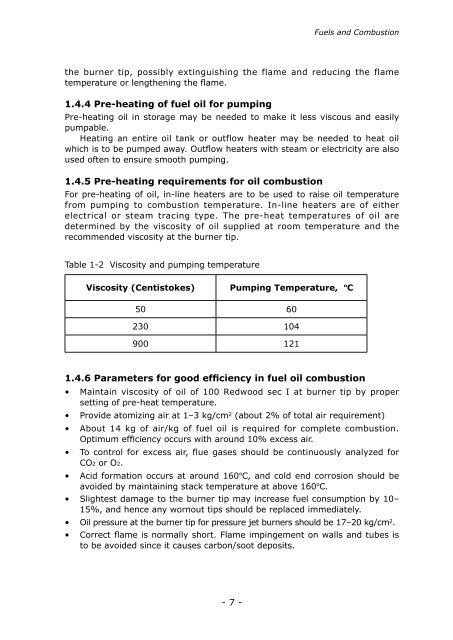Training Manual on Energy Efficiency - APO Asian Productivity ...
Training Manual on Energy Efficiency - APO Asian Productivity ...
Training Manual on Energy Efficiency - APO Asian Productivity ...
You also want an ePaper? Increase the reach of your titles
YUMPU automatically turns print PDFs into web optimized ePapers that Google loves.
- 7 -<br />
Fuels and Combusti<strong>on</strong><br />
the burner tip, possibly extinguishing the flame and reducing the flame<br />
temperature or lengthening the flame.<br />
1.4.4 Pre-heating of fuel oil for pumping<br />
Pre-heating oil in storage may be needed to make it less viscous and easily<br />
pumpable.<br />
Heating an entire oil tank or outflow heater may be needed to heat oil<br />
which is to be pumped away. Outflow heaters with steam or electricity are also<br />
used often to ensure smooth pumping.<br />
1.4.5 Pre-heating requirements for oil combusti<strong>on</strong><br />
For pre-heating of oil, in-line heaters are to be used to raise oil temperature<br />
from pumping to combusti<strong>on</strong> temperature. In-line heaters are of either<br />
electrical or steam tracing type. The pre-heat temperatures of oil are<br />
determined by the viscosity of oil supplied at room temperature and the<br />
recommended viscosity at the burner tip.<br />
Table 1-2 Viscosity and pumping temperature<br />
Viscosity (Centistokes) Pumping Temperature, ºC<br />
50 60<br />
230 104<br />
900 121<br />
1.4.6 Parameters for good efficiency in fuel oil combusti<strong>on</strong><br />
• Maintain viscosity of oil of 100 Redwood sec I at burner tip by proper<br />
setting of pre-heat temperature.<br />
• Provide atomizing air at 1–3 kg/cm 2 (about 2% of total air requirement)<br />
• About 14 kg of air/kg of fuel oil is required for complete combusti<strong>on</strong>.<br />
Optimum efficiency occurs with around 10% excess air.<br />
• To c<strong>on</strong>trol for excess air, flue gases should be c<strong>on</strong>tinuously analyzed for<br />
CO2 or O2.<br />
• Acid formati<strong>on</strong> occurs at around 160 ºC, and cold end corrosi<strong>on</strong> should be<br />
avoided by maintaining stack temperature at above 160 ºC.<br />
• Slightest damage to the burner tip may increase fuel c<strong>on</strong>sumpti<strong>on</strong> by 10–<br />
15%, and hence any wornout tips should be replaced immediately.<br />
• Oil pressure at the burner tip for pressure jet burners should be 17–20 kg/cm 2 .<br />
• Correct flame is normally short. Flame impingement <strong>on</strong> walls and tubes is<br />
to be avoided since it causes carb<strong>on</strong>/soot deposits.
















